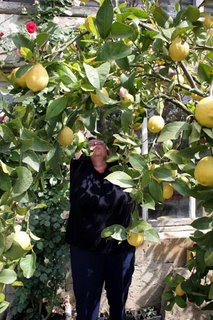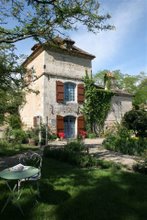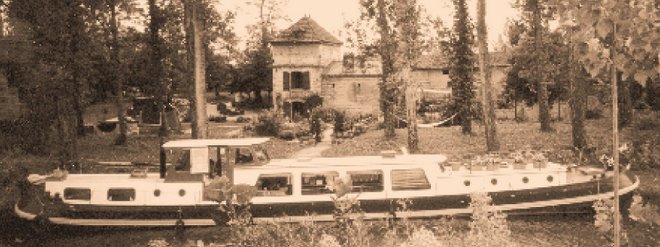September 25, 2006
Friday's children...
Friday- Wine
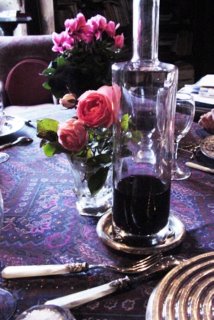
Pig, Duck, Beef, Armagnac… the end of the work 'Week in Gascony' leads to Saturday’s market and later that evening to an FCI/all cooks/all out jammin’ in the French Kitchen. So in anticipation and to give ourselves a respite from the competition style eating we’ve been doing, I plan a day of leisurely swilling and sipping chez two friends of mine, 2 Sisters in Aquitaine. Isabelle and Catherine Orliac's Chateau la Bastide perches above my beloved Garonne River valley near Valance d'Agen. We came looking for good red wine for Saturday’s dinner, what we encountered was a deliciously dark “family secret.”
I first met Isabelle years ago high atop the Garonne vineyards tending delicately made Bordeaux-style wines in the Buzet appellation. Returning to her ancestral home to join her sister, Catherine, they delved deep into the Orliac Family coffers for photographs and artifacts to place in a charmingly personal ‘musee de vin’ on the property. What they discovered set off a historic romp through the annals of Bordeaux wines and resulted in the tell-tale gossip of great-great-great aïeul whose river boat sunk in a Garonne flood in the late 1700’s causing bankruptcy and problems for the talented winemaker. From his soon-to-be last home at Versailles, Louis the Sixteen himself pardoned Jean Orliac in the summer of 1780 allowing him to continue to trade and produce his goodly and medicinally prized wines. It is one of his recipes that inspired the newest Orliac venture, a red-fruit flavored aperitif wine, not-so sweet/not so strong, that is aptly called ‘le Secret de Famille’. Deep ruby, framboise-scented, tinted with tannins of green walnut and other woodsy flavors, it is my own personal newest favorite thing to drink!
Making wines based on the Cote de Bruilhois appellation standard- Merlot, Cabernet Franc, Cabernet Sauvignon and the characteristic Tannat grapes, Catherine and Isabelle shared their other family wine making secrets with us on a pre-lunch visit. Care, attention, passion and pride marry the exceptional terroir of their 24 acre Roman site at Clermont-Soubiran. A love for the land that is bio-diverse and yields a forager’s delight of wild leeks and tulips, flowers and truffle oaks as well as carefully managed vines underscores a savvy and talented vintner’s nose. Dropping in during the middle of their working day, we are greeted by this fairy-tale pair of two sisters—one blonde and one dark, who conjure up magic on their limestone bluff somewhere in Aquitaine.
The FCI-Four departed with cases of a robust 2000, a softer 2002, and a 3-liter bag-in-a-box of the Family Secret. Saturday night’s dinner will be well lubricated and full of FCI gossip!
Stayed tuned for Saturday's feast as four FCI alumni prove that their can't be too many cooks in the French Kitchen.
September 18, 2006
Thursday- Armagnac
This is terroir on a plate. The deep golden ochre of a small patch of land down the hill from a stone building the same color called 'le Rey' is the quintessential definition of terroir. This is what makes armagnac--Armagnac. And this is what makes Guy Arrouy's spectacular armagnac a magical mouthful of honey-colored scents and flavors- the taste of Gascony.
On Day Four of the French Culinary Institute's "Week in Gascony", we drive the slow hills south into the Gers and into the heart of Armagnac production near Eauze. Here the Teneraze and the Bas-Armagnac regions nestle side by side producing both highly perfumed and full flavored eau-de-vies. Guy's land straddles the geological divide and so his output of both exceptional Cotes de Gascogne white wines and a bold and memorable brandy profit from this marriage. It's in the land, boys and girls.
Our 'tour' is in response to my love of this proud winemaker. Guy Arrouy knows I dote on his clean palate and fresh-mouthed wines. His Cote de Gascogne starts with a complex citrusy juice that he draws off the outside vats for us to taste. Sauvignon Blanc, picked and pressed yesterday, is sweet, fresh and hold the promise of a complex little wine. Next, we enter the stock room to taste last year's finished product- a Sauviginon/Colombard blend. But Guy's own pride is a 100% Gros Manseng wine that recalls the late harvest sweet wines of the Jurancon- this is a dry-finished Gascon cousin. With more patience than most American's allow, and only after we have sipped and swirled and swallowed approving the post-breakfast libation, do I dare reveal my dark ulterior motive. Dark as aged brandy, dark as a dimly lit cave, dark and smooth and soft as only a 36 year old armagnac can be.
By definition, brandy produced within the terroir-defined appellation is only called armagnac after ageing three years in oak barrels. When Guy invites us (ok, I begged) to enter the quiet unpretentious chai tucked behind a dozen large cement vats I began to whisper. This is hallowed ground; underscoring the resting spirits there is a zen-like attention to this private reserve. Don't show up and expect to buy any of this! Guy Arrouy only bottles on demand and the large 400 liter casks of resting 1970 and 1972 vintages continue to evolve in rustic tranquility.
With a long clear tube he siphons off generous tastes of his prized vintages. 1970."This is what they sell at Maxim's in Paris." 1982. "Someone in Washington imported this for a diplomat." 1990. "This is the last of what I make. The youngest but not too young." It is as delicious and seductive as only a 16 year-old farm girl can be. With a little bit of cajoling and a lot of gratitude, Guy finds an empty unmarked bottle and fills it by the siphoning tube. It is the color of deep caramel; the color of a slow-burning flame; the color of over 5000 sunsets that have warmed these stone walls cradling it's evolution. It smells of pruneaux- cooked plums and pear. It tastes of cocoa and vanilla and bay. It is smooth in the mouth leaving a lovely long souvenir in the mouth. It is Gascony in a bottle. This is a cook's brandy.
Thursday lunch at Chez Simone in Montreal-du-Gers finished with armagnac. Dinner back at the French Kitchen that night was splashed with armagnac- in sauces and used for deglazing pans. But the moment of glory came when we could sit around the vast round cask-bottom table sated from another day of discovery and good food. Passing the bottle of Guy Arrouy's 'Domaine de Rey' from hand to hand was the finishing taste of just another day in a Week in Gascony.

Thursday's Child. Guy Arrouy- distiller and wine maker
Domaine de Rey, Gondrin, Southwest France
September 15, 2006
Wednesday- BEEF plus
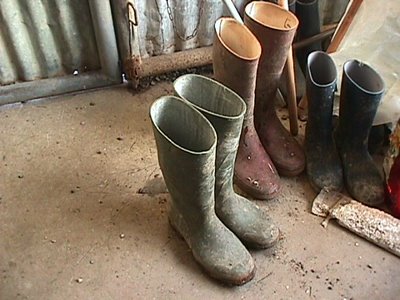
Ferme Bellevue
Sabadini Family
47310 Ste.Colombe-en Bruilhois
Wednesday Morning
The weekly Marché at Agen’s Place du Pin (tucked behind the MacDo’s now) waits for no sleepy heads, and after last night’s Duck Fest, the troopeaux are a little slow to move. Promise of a café au lait at the village bar rouses the FCI Four and we are out the door and shopping! Crayon colored umbrellas make neat rows across the parking area and under the covered structure.
Look at what we find and buy:
raw beets with their greens
coco beans in their pods
fresh shallots, onions and garlic tied in ribboned bouquets
mild red, yellow and orange peppers
savory/sweet Muscat grapes
extra virgin honey in its waxy comb
late harvest strawberries- Mara des Bois
home-made vanilla and coffee yoghurts
a sampling of excellent goat cheeses
Our baskets strain with the kilo weights and heavy plastic bags cut into fingers but where’s the beef?
We abandoned the vegetable and fruit stalls and artisan producers for a cross-town jaunt to the Marché couvert or covered hall just off the main drag in Agen. The Pineau Butcher brothers greet us in tidy, green pinstriped shirts and those sexy one-shouldered aprons. In this glass-front refrigerated case hang half-carcasses of veal, beef and lamb. I consider veal tendrons or veal bacon (les parisiennes we call them) to cook with onions and those colorful peppers. Maybe some saucisse d’Agenaise- their special 80% beef and 20% pork sausages to grill rosy until medium rare. Turning to my chicks, I notice everyone is at the other end of the counter.
In that glass-front refrigerated case hang half-carcasses of another four-legged animal. Big. Large muscled. Dark meated. Lean. Erik was the instigator. “Can we buy chevaline?”
Gulp. If you’re thinking Cold War and secret British missiles, go to the back of the butchery class. Think Chivalry, Chevalier and finally Cheval itself. Horse. Never before has a group of foodies, let alone a dedicated, educated group of FCI alumni requested horseflesh. Pourquoi pas?
Horsemeat. Steeped in culinary lore and mythology (a quick look at http://en.wikipedia.org/wiki/Chevaline dispels the notion that only the French eat horse!) horse meat is, in fact, high in protein and iron, low in fat and, in France, just as expensive as prime beef. No one in France eats horse because it is a cheap substitute. Instead it is a deliberate decision based on taste or health issues. Chevaline has long been fed to invalids to speed recovery, either raw as in tartare or cooked in a soup to enrich the broth. But here in Gascony, I always just hear about how good it tastes. By law, a French butcher must separately seperately from beef and chevaline shops were often topped with a statue or picture of the horse's head so as not to be led astray.
Ok, before I get too embroiled in a potentially sensitive issue, let me say that we purchased a sort of skirt steak that begged to be grilled for the pure education of it all. I, who have eaten snake, scarab bugs, grasshoppers, ants and caviar, was going to balk at a little horse steak? No way!
Salted, peppered and thrown over hot coals, Gary grilled and I served everyone a modest 2-inch slice. it got quiet before the usual yummy noises escalated to a happy hum. There was also the braised veal tendrons with meltingly sweet onions and red peppers; a grated raw beet salad made with walnuts, garlic and parsley; Magic coco beans cooked with the beet greens and lardons; Muscat grapes with goat's cheese and honey; a very American strawberry shortcake.
The cheval would just be an experiment, a gustatory amusement, a fleeting taste of the wicked and wild. WRONG. It was delicious. Utterly, meltingly delicious. A taste was not enough. everyone wished for more. Not a morsel left. A smattering of vinaigrette-soaked shallots married with the juices were mopped up with slices of good bread. Thank God for Erik’s CoCo beans that melted in our mouths in garlicky creaminess fullness and sated the tongue as well as the belly. And although Wednesday was for BEEF, it became memorable in our "Week in Gascony" for a little bit of Mr. Ed.
Earlier in the day, our afternoon visit to the Sabadini farm at the corner (my neighborhood “grocery store”) yielded a basket of eggs for a crème anglaise that never materialized (too much food!) and sweet plums destined for confiture des prunes. The working Blondes of Aquitaine (http://www.blondecattle.org/ for more info in English) were gathered around a muscular bull like so many filles in a harem pasture; a few long-legged calves tottered on new pins; the handsome young son of prize-winning Naomi, Apollon, eyed his future happiness through the barn pen. Chickens strutted, geese and ducks danced around the willow tree and the daily life of a contemporary French family farm lay exposed before us as simply as a board game.
Roll a pair of hens and move two steps forward, gather eggs; score a seven, miss a turn and clean the pig pens; a winning roll and a new calf is born with no help; score double noughts and it’s back to cleaning- the chicken coop this time, the rabbit pens next; wait a turn and harvest the three rows of grapes for daily wine; fix the Massey-Ferguson tractor and only then, when the game’s day is over, slide out of your boots, into your slippers and sit at the kitchen table for a meal of your own making. Like most farmers, the Sabadini’s eat the small bits- pork, chicken, rabbit, duck, saving the tender tasty Beef as their cash crop. The work is never ever done in this daily game of Family Farm, but we all win. Good food created by caring people in the Field to Plate, Farm to Table, Full-Circle Life of my Gascon neighbors, the people who turn dirt into food.
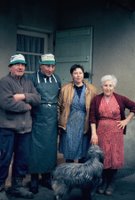
Thank YOU!
September 13, 2006
Tuesday- DUCK
So when the FCI Four announced their intention to consume as much foie gras as possible in this “Week in Gascony”, they didn’t realize how easy it would be in Southwest France to have duck, duck, or goose at every meal. Best of all here, in the heart of Gascony, small artisan poultry farms pepper the patchwork landscape from the Garonne River to the Pyrenees; to steep oneself in the foie gras culture we need only go down road and over the river to Vianne and Patricia Lamarouche’s farm, Puymartin.
We arrived at Puymartin just after the plucking and clean-up of a dozen fat tête rouge or Muscovy ducks. Prized for their flavorful fatted liver and beef-like meat, one duck would provide us with a menu of different recipes.
A déclinaison of DUCK:
grilled magret stuffed with foie gras
a wine-rich civet de canard
cœur de canard en brochette
foie gras en terrine
grattons
frittons
duck fat
grilled demoiselles or duck ribs
In her white tiled workshop, Patricia wields a sharp narrow knife like an extra digit and shows how the gutted carcass is divested of its manteau or cloak. The meaty breasts with legs and wings still attached are carved expertly off the rib cage in one piece. Then with surgical precision, she separates the back from front, trims the duck steaks (magrets), arranges the cuisses or legs, dices the fat and skin for rendering and presents us with a completed butchered duck in less time than it took me to write this paragraph.
Next, we choose from a tray of wrapped livers a small fresh foie gras to slip between the skin and the meat of the breasts before grilling and a jar of foie gras entire to serve on thick slabs of toasted bread. Rillettes, terrines, dried sausage, even duck chorizo are seasoned by Patricia’s expert hand. Her unerring palate is the reason there is always a line at the Lavardac market under her green umbrella. By 11:30 on a brisk market morning, the rabbits, ducks, and chickens that fill her refrigerated market case have all jumped into waiting baskets to join the farm fresh produce and fruit that completes a Gascon menu. No "Week in Gascony" is complete without this Tuesday’s child so full of grace. Merci, Patricia!
Guillaume DILHAN et Patricia LAMAROUCHE.
September 12, 2006
A Week in Gascony: Monday- PIG
I must have been too old to wear them or too young to remember; I’m not sure I even owned any but the image sprang to mind this week as Eric, Claire, Gary and David (all alumni’s of the French Culinary Institute) joined Vetou, Dupont and me for a “Week in Gascony—French Kitchen Adventures.”
During the week we shared a laundry basket of gastronomic colors. If as a group we wore our colors with pride, there is also no shame in sharing what we ate and what we cooked. This is Gascony—the great Southwest France. Here, business, life and love revolve around the table. And especially at the floating table of Camont. Join us for a week of good food and friendly neighbors in my Long Village- a floating table in France.
Monday - PIG
Charcuterie
This is what we bought, cooked and ate:
Boudin noir
Saucisson
Saucisse seche
Grattons
Paté a la tete
Pied de porc
Crépinette
A van load of pig parts. An appetite whetted by the salty parfum of sausage and hanging hams. And a hunger to follow the field to table trail. Sunflower fields, their heavy-seeded heads hanging in anticipation of the harvesters, line the narrow French roads. The plate-sized heads are fat with seeds pressed for oil or used for animal feed. Here at Baradieu, near Mezin in the Lot-et-Garonne, one family has adapted a new version of the family farm into a better working model. Come join us for a tour of what the 4th Little Pig would have build against the big bad economic Wolf at the Door.
Along with corn, barley, wheat, and oats that they grow, the sunflowers feed an artisan level pork production at the Chapolard Family farm. Not just another French Impressionist landscape, the bright sunny faces have now become two-faced. First the sunflower seed pulp milled with the other grains to feed growing piglets then, in an economic tour de force, the oil pressed from the tournesol fields fuels Jacques’ Peugeot 505.
On this family farm, every few weeks, 5-6 sows throw a litter of 12-15 piglets that Bruno will care for and feed, then together with his brothers- Jacques, Dominique and Marc will bring to slaughter. Each Monday morning the brothers are joined by their wives and a few helpers to first butcher and then transform the succulent meat into delicious lardons, ventrêche, boudin, saucissons, saucisses, jambons, paupiettes, pates, terrines…
Tuesdays and Saturdays at Casteljaloux, Wednesdays at Lavardac and Saturday at Nerac a line snakes down the crowded market alleys as loyal customers line up to buy the high-quality selections of ‘L’Art du Cochon’.
“We are selling more than pork”, Dominique confides to us as we stand in the narrow white tiled laboratoire in our plastic booties, “we are selling confidence.”
“We notice our customers are younger, with young families, and that they rely on us for help: how long to cook a pork shoulder roast; how much Saucisse de Toulouse to buy; how best to store the smoked bacon; when to eat rillettes…”
“We sell a relationship, not just meat.”
Tomorrow-
September 02, 2006
T is Terre, Terroir, je suis une Terroirista.
dirt
soil
geology
rain
wind
sun
heat
cold
work
history
love
The sum of these ingredients is a recipe for terroir.
This week I begin a week of being a terroirista as I welcome a group of French Culinary Institute Alumni to my French Kitchen in Gascony. Gascon this and Gascon that, the Cooking of Southwest France, local, neighbors, corner farm, blah, blah, blah. They'll be sick of hearing me spout off about how good, how delicious, how fresh, how does this even work still...
Pigs, Ducks, Cows, Fowl, Wine, Fruit, Armagnac... It's a compressed week of 20 years of living here in France's hidden garden slapped on the my floating table every night. They'll get dirty, they'll get tired, they'll get drunk- then cook. Jambon, pied de porc, magret, demoiselles, tete de veau, boeuf a la mode, pintade a l'armagnac, poule au pot, pruneaux au vin, peche de vigne, chasselas...
Stay tuned and be prepared to be hungry. This French Mother Earth has her apron on!
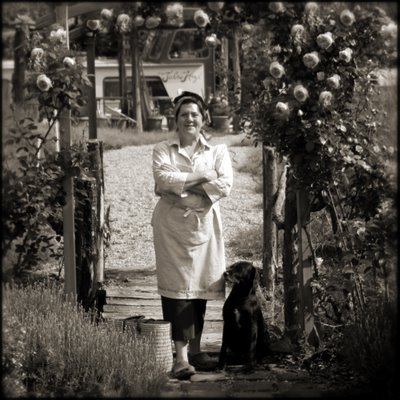
August 05, 2006
S is Summer!
Summer takes a breather and the killer heat finally retreats into a damn good imitation of fall this misty morning—overcast skies and sweatshirt cool. Across the canal, abundant blackberries overgrowing the bank are whispering, ‘Harvest me. Harvest me.’ A mother duck stops her teenage brood to pluck mures dangling over the milky green water. Mmm... Duck breasts with blackberry vinegar?
It’s but the first week of August. Summer vacationers have jammed the French roads and the littoral is littered with sand-crusted European bodies. David L tells us “Paris is closing” but Southwest France is just opening her fat food basket and while neglected chores stretch across the barge, from emails to dirty bilges, I have an idea. On this quiet Saturday morning in August, I settle for a little ‘garden archaeology’- a much-missed tour of the overgrown potager, abandoned for a month of travel on the Julia Hoyt, before my morning chores rein me in. I pout at the keyboard, then bolt and shout to no one at all, “I’ll be back!”
Thirty minutes later. Even the abandoned garden yields a full basket of food: several kilos of tomatoes, a few hot peppers, three over-large courgettes, a handful of cherry tomatoes, one bitter lettuce, some stray leeks and all the herbs I need to make a summer soup- savory, mint, thyme, chives, lemon verbena.
In my absence, a volunteer morning glory knitted the raspberry canes together next to the guinguette/garden shed. They yield a flower pot full to the brim of red thimbles punctuated by a handful of cultivated blackberries. Once again the squirrels and friends have scored the lion share of the noisettes from the hedgerow but I think there is enough to stir into the found berry jam. Enough to make two pots; one to greedily eat now and one to save until the winter blues.
The green gage plums or prunes reine-claude are still crunchy sour, so those that fell at my feet (at my insistence) will get pickled- a sort of green plum chutney for a pork roast fest. The slightly stunted eggplants and the rest of the tomatoes will roast until thick and sweet; I’ll jar them all and save them for the winter cooking classes when I need to recall summer inspiration. I am at my best writing menus when I have a handy palate of textures and colors to pluck from. Camont becomes a quirky edible paint box for my French Kitchen Arts.
Summer Lunch:
French Potager Gazpacho- a Summer Soup
Pork Shoulder Roast served with Green Plum Chutney
Confited Tomato and Eggplant Tartines
August Harvest Tarte
with raspberry, blackberry and hazelnut jam and pears.
and for breakfast tomorrow...
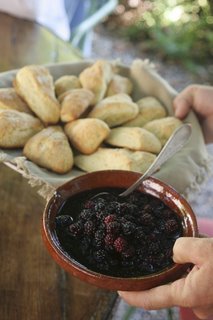
JC's Blackberry Scones: TIM CLINCH
June 30, 2006
Think pink- R is for Rosé

It comes in a bottle, it comes in a box
From Barbie pink to cherry pop.
Drink it dry, drink it cold
Rosie wine makes summers bold!
I’m sure if I need to give blood for a transfusion this week the startled staff at la Clinique St. Hilaire would decant several liters of crystal pink summer wine. It’s been hot in Southwest france this June. As work progresses on the Julia Hoyt ‘Summer of Love’ 20th anniversary facelift party, the crew and I are fortified by long lunches and chilled bottles. After nearly 304,200 square inches of painted surface (two coats please) I have grown to appreciate the fortifying qualities of cracklin’ rosie.
Cracklin rosie get on board… This store bought woman can’t keep up with the demand so we shifted from bottle to box; the little 3-liter box from the Buzet wine coop down the road has a photo of a pink-filled wine glass on it for those who can’t take the time to read the label. I’m sure Gertrude Stein was misquoted—a rosé is rosé is a glass of rosé is a pitcher of rosé …
This rosé by any other name is summer wine. Even the national wine chain store in Agen carries 22 different rosés in stock. Every small winery from here to Bordeaux (about a thousand of them!) lets their grapes from young vines stew just one night then drains the skins and pips from the juice to create a clear pink easy to drink table wine. I like to think of this as red wine in training; we get the fruit, the alcohol lift, the chill with none of the serious tannins, oak and pretension. That can wait for a winter night in front of the cheminée.
Back to the bleu bateaux and it’s serious lunch time break. When M-France and Sarah stopped by for a few pruneaux and some foie gras on a whirlwind photographic tour of France we celebrated their arrival with our usual family lunch. Yannick is covered with metal fillings from the grinder, Babeth’s nails are varnished the same English red that she is painting the hand rails, Emile and Clotilde are painting the bottom of the rowboat in preparation for it’s summer launch party. Vétou has stopped her impromptu upholstering in the wheelhouse to help me get lunch on the table for the hungry crew.
M-France, too long gone from the rigors of the French table, asks, “You don’t eat like this every day?” I pour her a little Vin de Noix that I had made from green walnuts, eau de vie and rosé wine. “Not really, we usually cook something more substantial but I didn’t go shopping.” Vetou passes the bowl of lentils and platter of sausages, a found salad of tomatoes, cucumbers and red peppers; the pink bottles are frosty straight from the half-pint sized refrigerator. Yes, we eat like this everyday especially when working hard keeping this hundred year old bleu bateaux in good nick and when long lost friends arrive from the far away life.
June 03, 2006
May 31, 2006
Bonjour! from the Bleu Bateau Café
Not all French food is complicated. Here in the sweet countryside of Southwest France, I have found the little tricks and secrets that make cooking like a French grandmother easy--a busy French grandmere! The best and freshest produce jumps into my market basket every Saturday as DuPont and I jump into the 2CV (that little cartoon French car!) and head to Nerac along the Baise River. An impromptu menu begins with radishes with their greens for a simple peppery soup, a bundle of fresh garlic to rub over grilled country bread, a duck breast to grill, slice thinly, and drizzle with a red wine sauce made with a glass of wine, a shallot and some honey to sweeten the end. I drown a box of ruby strawberries with a vanilla pod in a bowl of wine and some sugar cubes and serve it in glasses for dessert. Simple, easy and so French!
Shopping in the small villages that line my canal, a Long Village of good food and wine, is a fat lesson in French cooking. The baker, butcher and wine maker will tell me how to prepare their favorite dishes; my neighborhood is like a living cookbook. Afterwards, sitting in the village café with a petit blanc (a little white wine) or a mure-rouge (blackberry and red wine) with DuPont at my feet, I write the little stories that my market friends have told me. My French neighbors love good food and they are proud to share their specialties in tips and tastes. Curious about what and how I cook, Xavier asks me if I know how to stuff a quail with grapes and cook it over a bed of vine clippings. Dominique tells me to place a bay leaf between each slice of the pork roast he is cutting for me, wrap it in bacon and roast it for 20 minutes a kilo- no more! Francoise slices pain d’epice, like gingerbread, and serves it with a dab of duck rillettes, it becomes a new favorite. Jean-Francoise, the self-crowned King of Ducks, hands me a slice of salt-and-pepper-cured magret or duck ham wrapped around a nugget of raw foie gras. Take that you supermarket wimps!
At the end of the umbrella-ed allée is a small stand of organic treasures- fresh garlic, sweet beets, tender courgettes and the first real cherry-like tomatoes. Now I have dessert! By the time I load the trunk of the raspberry red convertible I have enough recipes for a chapter in a new book- ‘Eating the Long Village!’ ; by the time I return to my Van Gogh blue barge, tonight’s dinner has solidified into a gentle and easy meal to cook for friends. Don’t forget- "Cook fast, drink light, have fun! "
Menu
Aperos sucre-salé
Duck rillettes served on gingerbread toast
Soupe aux fanes de radis
Radish leaf soup
Roti de porc en robe de ventrêche et laurier
Bay-scented Pork roast wrapped in bacon
Dessert en douce!
Savory dessert- sweet cherry tomatoes
served with real crème fraiche and sprinkled with olive salt from Majorca.
A creamy rich fresh tasting savory surprise to finish the meal with a sweet wine!
May 20, 2006
shop local: Spring turnips and radish greens with flirting on the side
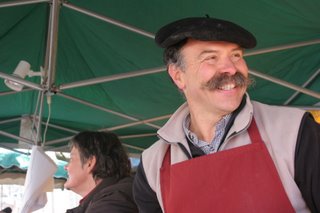
The Saturday morning market at Nerac is Flirting 101. Newbies Brits and other tourists make their way cautiously down the crowded narrow corridor of bright umbrellas—a gauntlet of fresh meat, artisan charcuterie and the best and freshest local produce. Their fear and timidity palpable as they try to decipher ‘safe’ paté from French disguised offal; compare kilos to pounds and euros to pounds or dollars. They shop with their eyes, but they haven’t learned the difference yet between the local producer vendor with a few cases of crisp apples from his own orchards labeled “coteaux de Ste. Colombe-en-Bruilhois” and the marketeer who brings in produce from the marché au gare or wholesale market from as far away as Israel and as close as over the non-existent border in Spain. They don't get the flirt because they are so afraid.
Seasoned French housewives and vieux garcons use baskets, canes and umbrellas to keep their place in competitive lines. (ask David Lebovitz about his encounters with les French furies!) They shop every week, they watch the prices by the centime, they buy half-loaves of bread, a smaller wedge of cheese, barely two hundred grams of perfect pork roast. They are not to be trifled with but to be watched and in watching learn their shopping strategies and techniques. They may not look the type but they flirt shamefully if a few more euros are at stake.
As an inside-outsider (having lived nearly 20 years here) I play a different game. I’ve learned the names and weaknesses of my favorite vendors and I trade on their friendship mercilessly. I bring a jar of my homemade apricot jam to Bernard who doles out a sample of perfectly-aged Manchego cheese and then announces a little too loudly to everyone in line that "he knows what I like". I buy a half of round of Brillant-Savarin that has a texture to rival the best butter I ever ate and a wedge of that Manchego that he brings back from central Spain when he visits his family. (That's another definition of local-where your family comes from.)
Hearts beat quickly as I approach the gastronomic bazaar of Kakou, a long extended wagon unfolded to display the variety of artisanally produced breads, sweets and charcuterie. Regardless of pretty Francoise’s eagle eye over her long-haired and smiling Kakou, he comes out from his knives and sweet hams to exchange the Gascon bizou- a kiss on each cheek and then another pair of sweet pecks. It’s double or nothing here in the Southwest.
While sipping a taste of cold saffron aperitif and nibbling a slice of saucisson aux noix and a piece of pain d’epices, I choose a loaf of pain levant, slightly sour and nutty at the same time, and two hand cut slices of ham. I leave lighter in spirit if not in kilos.
The market compresses its last few meters and the crowded line at the Chapolard brother’s “l’Art du Cochon” is my last stop. I watch anxiously as the last fresh sausage is sold. I modify my order as the boudin evaporates client by client, the ventrèche goes and the peppery dried tenderloins gets spoken for. My menu disappears into other people’s baskets. The line moves excruciately slow as each customer oversees the careful wrapping and weighing of kilos and kilos of carefully raised pork. Where as this is just a once a week ritual for many, it is a commited relationship for me. The flirting is more serious here. How many people are coming to dinner? When do you want to eat that dried sausage? Have you ever tried cooking the shoulder roast with bay leaves and shallots? The ultimate serious flirt is to seduce you with the best. This pork is so lovingly and carefully raised that the Brothers Chapolard might just as well come to my French Kitchen and cook it for me. Twice a week, four brothers and their wives trade rubber boots and butchers aprons for market clothes and smiles. They offer the best they can grow and sell it with pride.
Like a 13 year old with a crush on her teachers, I fall in love a little each week at my very local very good marché. Love make shopping local easy.
My Market list for Saturday may 20 2006:
A packet of fat radishes with very fresh greens
A bunch of young shallots sprouts
A Batavia lettuce
4 artichauts
3 kilos of apples
A wedge of manchego
Half a round of brilliant-savarin
A loaf of pain au levant
Two slices of ham
A kilo of cherries
2 bunches of spring turnips
A chunk of lightly smoked bacon
A terrine de porc
Two pigs feet
One saucisson
After the market Menu back on the Gascon ranch-
One Sausage slice and a glass of kir gascon
Spring turnip and radish leaf soup
Served with a slice of home-cured bacon
A green salad with simple vinaigrette
A chunk of bread
A slice of cheese
A hand full of cherries
A glass of good very local wine- cotes de brulhois
See you in Nerac next week.
May 11, 2006
'P' is for pelle
Digging in the thick clay Garonne River floodplain is hard work--fertile, sticky, dense, rocky and full of centuries old weed seeds. This is not the gardening they show on TV, this is not even the part I remember last year when PBS's Smart Gardening program filmed my potager. I think this is the part of gardening memories that evaporates like rain clouds in the last three drought dry summers. Why is there not a chintz print gardening tunic? Candy colored gloves? Elegant little wheelbarrow? I'll tell you why in two words-
cow shit
My new capri summer pants are now grass and other stained.
My nails are dirt-encrusted even though I was wearing serious gloves.
The rusty wheelbarrow is slopped with manure enriched compost from the Sabadini farm up the road.
so why am I smiling knee deep in merde?
I have seen the effects of this dark magic at my neighbors farm. Hay grows lightening-like under the spring sky; peach trees blossom clouds of future fruit; a solitary lemon tree produces a treasure trove of citrons to sharpen summer cooking. So whenever I can get Denis Sabadini to drive his tractor down the little one lane driveway that links 11 varied houses on this chemin de campagne, his front loaded bucket full of well-rotted straw and manure, I am the happiest neighbor in this Long Village.
For the last 5 days I have been digging, weeding, clearing, wheelbarrowing. I smell like a farmer. I am happy. As my good friend Franny G. says, it's time to call "a shovel a spade."
P' might stand for the sweet parts of the potager--
the petits pois just planted,
the parasol that shelters the table,
the pommes de terre we will dig for summer salads--
but I know it really stands for pelle- the spade with which we shovel all that shit.
Here's to my Long Village neighbors!
May 05, 2006
'P' is for Mole Poblano
1. The potager is in the shade of the oak, walnut and acacia trees.
2. The late sunset (around 9pm and counting just now) seems to intensify the perfume from the aforementioned acacia blossoms. It's like working in a perfume factory.

It took me three days of here and there, but the grass paths that define the tic-tac-toe design of the eight 5X5 meter square beds is mown; The tomato plant stakes have been removed to a fix-it pile; the first square is nearly weed free. This means I am now allowed to buy tomato plants tomorrow at the marche au gravier in Agen. Thus begins the salsa square.
Canned, sauced, souped or pureed, most of my meaty French tomatoes will go for salsa to alleviate my cravings for the other Southwest-kine food. The jalapeno and tomatillo seeds will crowd the already foot-high seedlings that I'll buy at the market tomorrow. Cilantro seeds will be spread among the seedlings and last year's onions are already multiplying. Sweet corn will fill one square itself. All I miss are fresh corn tortillas.
As the garden year begins at the French Kitchen in earnest, I look forward to salsa enough to last until next Cinco de Mayo. I am glad the French lost that one! Thanks to my franco-American potager, I can enjoy the best of the South-West in the Sud-Ouest. Ole!
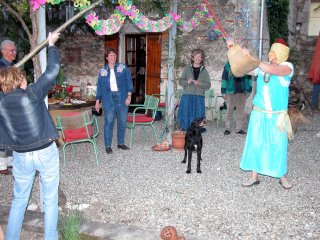
Garden Meteo- covered skies but warm and clearing; wardrobe-starting with a sweatshirt and ending up in a sleeveless T; Woad blue eyeshadow and coral earrings.
Time spent: negative because of nostalgic moments for last Cinco de Mayo party.
May 03, 2006
"P" is for Potager: French Roots Day #1
 I am late this year getting the potager in order. A month in the States teaching a Navarin d'Agneau- the French Kitchen way, attending the IACP conference in Seattle and working on 'THE TV Project' leaves me French-lagged rather than jet-lagged. It takes a week or so to adjust to two-hour lunches, bottles of wine for dinner, naps, slow market/shopping/gossiping, etc.
I am late this year getting the potager in order. A month in the States teaching a Navarin d'Agneau- the French Kitchen way, attending the IACP conference in Seattle and working on 'THE TV Project' leaves me French-lagged rather than jet-lagged. It takes a week or so to adjust to two-hour lunches, bottles of wine for dinner, naps, slow market/shopping/gossiping, etc.Last year at this time, the Potager was camera-ready as Dawn Ford and her PBS-'Smart Gardening' crew arrived to film a few French segments here at the French Kitchen. (More details on air dates at the Smart Gardening site!) I begin to rush to get things in order until I realize that for the first time, I am on schedule with what the old French folks say- wait until les saints de glace has passed to plant tomatoes.
So while William Alexander is enjoying the fruits of his $64 Dollar Tomato labor, I begin to think of my potager in how much time spent-- those hours of preparing and planting what will become my summer fast food. This is my Spring blog diversion into the world of the French Kitchen Potager: French Roots- a game of tic-tac-towpath.
Day 1: weather report- high wispy clouds, too much wind from the Mediteranean- the tramontana, high mid 5o's, wardrobe: brand new U.of O. fighting duck sweatshirt and a Miss Marple garden hat.
Idea- mow the grass paths and clean the beds of winter weeds. prepare one bed for planting all the seeds I brought from the States for the "American Square": Tomatilla, Okra, Jalapeno, Sweet Corn, etc...
Reality- get gas for the lawn mower , sharpen the blade since it can't cut through the tall damp grass, find the tools long scattered to barn, shed and boat, buy sunscreen, change shoes twice, find gloves, stop for water... play with Dupont. it'll be easier tomorrow.
Time Spent: nothing yet...

DuPont- part bird-dog, all mutt.
April 25, 2006
"P" will be for ...
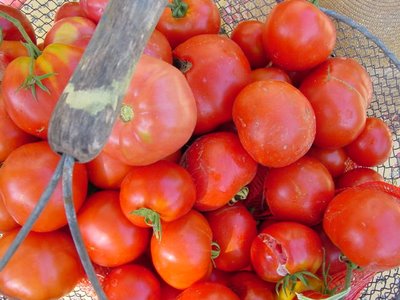
harvest late summer 2005
April 14, 2006
“O”- When one egg in not an Oeuf.
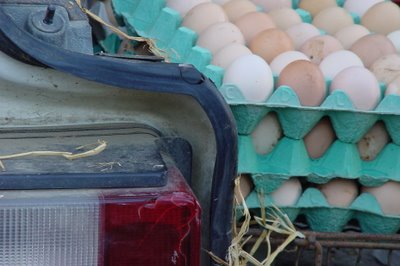
Easter: a joyful time of spring and greens and chocolate; asparagus, artichauts and strawberries. This is a time when counting one's blessings of family and friends, I always remember that one chocolate egg is never an oeuf.
Saturday Morning Market Rituals: French EGGS
I bought a dozen farm eggs at the market today from a vieux garcon wearing a well-worn beret in the Gascon style, pinched in the middle over his nose like an awning. He had a hand-woven willow basket full of thin-shelled fresh eggs in every possible shade of pale brown; freckled or smooth, large, medium and small, pointed, round and with bits of straw still sticking to the shells. Carefully, he placed them in a plastic sack; we exchanged two Euros and 12 eggs.
Back on board the Julia Hoyt, I made a golden omelette with the three shattered eggs that didn't survive the swinging, singing walk with DuPont back to the barge. The yolks are as dark as marigolds and fragrant as saffron; the cake I bake will be sunflower yellow; the stuffing for the poule au pot will be butter-colored and taste of cheese; the creme anglaise to sauce a dark chocolate cake will be rich and honey-colored; the sabayon to pour over the first field strawberries-- tinted gold with these ripe hen's fruit. Oh, French eggs! There is no contest on what comes first, the chicken or… the Oeuf.

This egg-rich sabayon et fraises is for my dear friend
Heidi Cusick Dickerson
Soixante Bisous pour ton Anniversaire H!
For one pound of Strawberries
Sabayon
3 farm fresh egg yolks
3 Tablespoons white sugar
1/4 Cup sweet wine ( I use a Cote de Gascogne made with Gros Manseng grapes but any late harvest or Sauternes-like wine works)
1/3 Cup heavy cream
Wash and trim the greens off the strawberries.
Cut in half and place carefully in a gratin pan or attractive shallow baking dish.
Prepare the Sabayon by:
Whisk the egg yolks, sugar and wine until frothy in a heavy bottomed saucepan.
Place over a medium-low heat and continue to whisk as the mixture heats.
Keep an eye on the flame and be careful not to walk away as the eggs will start to thicken and curdle if left too long over too high a heat. (This can be done in a bain marie or over another pan of water but I am too impatient!)
When the egg mixture just starts to thicken enough to coat a spoon, remove from the heat and pour into a cool bowl.
Let cool briefly while you whisk the cream into thick peaks.
Then fold all but 2 tablespoons of the whipped cream into the egg mixture.
Pour the still warm Sabayon around the strawberries leaving just the tops exposed.
Dab the remaining cream over the surface followed by a sprinkle of raw sugar.
Place under a broiler and watch- it takes just seconds for the sabayon to brown.
Remove when golden and serve warm. Serve with a glass of chilled sweet wine.
March 02, 2006
N is for les New Yorkais

After being stuck in a foreign city mode here in the Gascon Alphabet (London & San Sebastian), I need to segue back to Gascony before I lose my blog identity. What perfect timing when some New York city mice came to the French countryside in the guise of a weeklong trip to teh Frenhc kitchen by some French Culinary Institute alumni?
Last fall when visiting Christopher Papagni at the FCI in NYC we talked about an alumni trip to France to explore the source of good Gascon products—from foie gras to armagnac. Nobody new then that this group of 7 (plus Vetou, Franny, Florent, Dominique, Christiane, Kakou, Françoise, Priscilla and DuPont) would set a world record for laughter and good times in the kitchen, farms and markets of my Long Village.
Camont was a noisy hive of French Kitchen Adventures last week as assorted waterproof boots (including breast pink Wellingtons- for the cure!) stomped though the mudluscious farm of the Six Little Pig’s. During the week we cut ducks into confit-sized pieces with the Duck Queen, chilled out in the armagnac chapel and turned blue with woad envy. When people ask what do I do in France, this is the best way to find out—just show up!
The week began on a sloppy note as heavy rains turned the farm roads and barnyards into heavy clay mud puddles- a perfect atmosphere to re-create our own ‘some pig’ memories at the Chapolard brothers’ farm near Mezin. From admiring the cojones of the Big Boss Boar to cuddling newborn piglets to salivating over hams and sausages curing in charcuterie-scented chambers, we followed the FH's happy chain from field to table. This small artisan production--just 30 sows, supports 6 families! The four brothers discovered that the key to successfully competing in a industrially farmed world is to complete the whole chain from consumer to producer-from sunflowers to charcuterie then bring it to the buyer at three weekly markets in the area. Their market wagon banner proclaims ‘the Art of the Pig…from producer to consumer’ and their welcoming smiles tell the story of people who pride themselves on sharing the fruit of their labor. For more about a love affair with terroir…www.savoringthewholehog.blogspot.com
The rest of the week moved at top speed- from farm to market to village café to 3-star Michelin restaurant. By Saturday- the gustatory finale of a week of research and devouring, 'don't be sad' had become a password for French Kitchen madness. No one was really sad as New York friends joined Gascon neighbors and we laughed and laughed and laughed. FCI graduate hands produced small plates of radishes and butter, creamy potatoes, jambon et pruneaux kisses, eggplant and tomato tartlets, fennel and olive salad, bite-sized wrapped brie bits, Muscat-laced sabayon made with rich farm eggs and enough Gascon sangria to float a 65-ton barge.
The international lingo of ‘Salut!’, ‘Cheers!’ and ‘Sante!’ floated to the farmhouse rafters as Camont’s roaring fire kept hearts warm on a chilled February night in Gascony. Sometimes in Gascony, ‘N’ stands for les New Yorkais and for those who show up!

Thanx Bruce!
February 16, 2006
M is for Morue- salt cod to you.

Looking for Salt Cod in Spain,
lost in a tinker's party at
the Kathedral of San Sebastian,
Donostia,
Midnight
Basque Street Madness.
Pintxos came and went,
Txakoli & sidra in fat glasses emptied
over & over
to the tink, tink, tink
of a thousand small hammers
on a thousand tin pots.
In France, morue/salt cod
is sober-
potatoed-
parsleyed and garlicked.
Simple Lenten Food.
Here,
in the Pays Basques,
saffron
peppers &
tomatoes
color the salted crystal kokotxas as festive
as a thousand tinkers in a pre-carnival fete.
"M" is for Merci for my Basque neighbors in The Long Village and you.
photos: MOHowerton
February 10, 2006
L is for Londre…
 Pussy cat, Pussy cat where have you been?
Pussy cat, Pussy cat where have you been?I've been to London to see the Queen.
Pussy cat, pussy Cat what did you there?
I frightened a little mouse under her chair.
The chair was in the spare white-on-white eating hall of St. John’s Restaurant. The Queen was not there, but the prince of nose-to tail eating was—Fergus Henderson.
Near the junction of St. John Street and CowCross Street across from the ancient meat market of St. Bartholomew, Henderson weaves a gustatory magic with the slightest of hands. His cooking is as straightforward and just as beat poetic as his speech. “ A bit like Christmas, isn’t it?” as he describes the gifts that people bring him to cook: a jute bag of wild garlic, a whole calf carcass being driven from Scotland, a bag of fennel pollen from Italy. “Happy table” as the dining room chatter of the City’s ‘suits and ties’ elevates to match the happy food.
And ‘happy’ does enter often into the conversations at our own happy table as Judy, Tricia and I dine with Fergus on a midwinter menu of crispy pig’s cheeks in a monk’s beard salad, roasted woodcock and wild teal and beetroot. “If the animals live a happy life that means the farmer is happy. If he’s happy, the cook is happy with the food he gets. When the cook is happy, we’re happy when we eat the food. It makes a happy chain.”
I watch the head chef and a tight kitchen staff of five define Henderson’s highly touted menu with modest gestures born out of sure hands. Surely, they too are happy. Head chef John Wigley plucks the feathers off the woodcook’s heads before tucking the stiletto beak into it’s own breast. They roast with their innards still tucked in to be served as a gamey tripe on toast. Fergus smiles, “Fortunately, they poo before they fly.”
“Look here.” Fergus leans into the tightly packed treasure trove walk-in cooler- a side of beef, several legs of lamb, a suckling pig, a bucket of calf tails and tongues lie in waiting. Cooks bustle the meat into recipes. The piglet gets tin-foil earrings. A large meaty rabbit is wrapped in fennel twigs and trussed with bacon before being cooked slowly in the bread oven. The fennel-scented meat served in a large bowl at the table with ladles of the winey broth.
Pots of stock are cooling on a counter as a pail of carrots are peeled and left whole to cook “because they stay sweeter.” They glow neon orange in the monochromatic setting. A plate of cooked sprout tops—a deep green punctuation to the slow roasted, braised and meaty menu. Rhubarb Eton Mess is a mosaic of delicate pink stripes over a scrumptious cream and meringue dessert. These color points are not accidental. Every detail is thought through from the crispy waiters’ white to the sole graphic design of the black and white portioned pig logo on a small ashtray. It is a thoughtful kind of place.

Sometimes the best thing about living in Gascony is how fast I can get out of town: to San Sebastian-3 hours, Barcelona-4.5 hours, and when I couldn’t think of a French ‘L’ word- Londres, just 1.5 hours by flying pig.
January 16, 2006
Sant'Antonio- bless this little beast

January 15, 2006
Gimme a pigfoot and a bottle of Buzet...
My inspiration for tonight’s Pig Blogging Sunday Supper menu came as it often does—from the immediate, close-at-hand good friends and neighbors in my homeport ‘hood in my Long Village.
Last night I sought help at chez Pompèle in the tiny riparian hamlet of Lamarque near Tonneins. My god-daughter’s birthday was the occasion; the pre-teen dinner built on special requests- pizza, a gratin de pâtes (macaroni and cheese!) and chocolate cake. Not even coming close to the kind of inspiration I was hoping to find until grand-mere showed up.
Mémé Vetou Pompèle is a natural. Her palate, honed by thousands of family meals, is sure and subtle. She can taste the black pepper missing in a pâté de foie or sniff out the armagnac added to a tourtière. So as the ‘tweens ate and chatted while watching French pop stars, Vetou and I drank champagne and talked pork. How she came to be so sure about all things kitcheny. I call her my French kitchen godmother, but she has been my teacher for fifteen years. she even teaches my friends when they are really nice to me.
“The Fête de St. Porc is ritual born out of necessity. Maybe the mysticism built around the slaughter, the curing and preserving of meats comes because it is important to work carefully and not waste a year of tending the meat by being sloppy. As well as honoring the poor bête!”
So this pig killing ritual imparts structure and lends moral and logistical support.
Vetou’s thoughts ran as fast back over 40 years as she could talk:
• I married into Claude’s Italian family; I was coming from a Breton/Italian mix.
• My Italian mother was a seamstress; skilled with needle and scissors but hopeless in the kitchen!
• The Pompèles were tenant farmers with four growing sons and a daughter- with nothing spare to waste.
• In the Garonne Valley the Italians brought the savoir faire of charcuterie that my Breton family lacked.
• In Brittany the entire pig is salted, right down to the tail- kig ha farz is an example of a Breton salted pork dish.
• My belle-mere was the expert boudin taster- now I am the one that makes the decisions: how much salt, how much pepper…
So back to that pepper- Vetou’s own secret. Four times as much pepper as my other neighbors use in their saucisses, saucissons and pâté! Black pepper infuses the flavor of Southwest France like a seawind carried across the years from the spice age. Think of those Indian ships docked in Bordeaux’s port de la demi-lune heavy with peppercorns, worth their weight in gold as now we thoughtlessly sprinkle a bit of dusty afterthought on today’s pale table. Poor pepper. I keep an old coffee mill grinder on the kitchen couner filled with peppercorns like Vetou taught me. The fast turning friction of the metal gears release the pungeunt oils- what a difference from the few crank, crank crank of a table top shaker.
We talked about the local Jambon de Tonneins, a protected secret recipe shared by four butchers in this little riverside not-much-of-anything town. Once I was allowed into the ‘laboratoire’ at chez PONTHEREAU and spotted a bucket of peeled garlic cloves. “5 kilos for 5 jambons…” I heard the maitre charcutier mutter before he abruptly stopped. The jambon is pulled apart once it has cooked in an autoclave with the vegetables, spices, black pepper. Sold cold, geléed in a glass jar or can, it is eaten cold like a pate or heated over boiled potatoes.
We talk of Roulades. Roti de Porc aux Pruneaux.
“Come on Vetou! I need help to decide what to cook tomorrow for this pig thing I am doing on the internet…it’s sort of a game” I explained. Blog has not entered her vocabulary yet.
“Bon, une roulade, a poitrine rolled around a stuffing and cooked.
A nice soup aux chou with a morsel of ventreche.
A cassoulet.
An estouffade of Pork with Onions and Madera and Armagnac."
We were getting closer but it was late and I needed to go home. Late to be driving the black pitch narrow roads over the river and through the fields… I kiss everyone four times (20 kisses not counting the dog) and as I reach the door, someone says… “Kate, do you want a pied de porc? And some boudin?”
Last minute reprieve. Merci, my dear generous Gascon friends, who always have what I need and never hesitate to share. Especially their good food. That last-minute parting gift became the inspiration for my
Soup aux Deux Celeri et Bacon- Kate Hill
Boudin, Pomme de Terres et Pomme de l’air- Paula Wolfort
Pig’s trotter and Chicken- Fergus Henderson
as Ol' Hannah’s say--gimme a pigfoot and a bottle of beer.
January 13, 2006
K is for me.
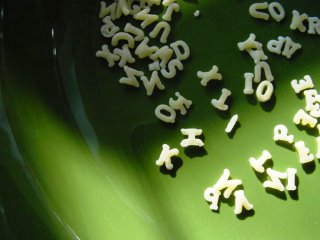
a, b, c, d, e, f, g, h, i, j...
'k' is not a very French letter. Most words beginning in 'K' are foreign like le kimono, le kookaburra, and le kangourou. In fact, half of the words in the kid’s dictionary I use are from the other side of the planet from France. Peut-etre, ‘K’ is just a foreign concept like… me.
A friend once called me an ‘inside-outsider’ here in Southwest France. Having lived here afloat along the Canal de Garonne for nearly 20 years, I am accepted by neighbors and friends as being, well, just Kate. No “Madame this” or “Madame that.” Whereas my friend Vétou has called her neighbor Madame Auch as they morning coffee together for 30 years , my rather formal widow-neighbor Mme. Dupuy, calls me just “Kate”. And always has. Not very French to call someone by their first name! And me, a ‘woman of a certain age’ even. Perhaps it’s because neither of my names sounds French. Kate doesn’t conjure up Kathryn or even Kathy to le francais and “Hill” comes out 'eel/ill'-- with a bit of a hiccup.
“Just Kate” also means I have crossed the formidable line between vous and tu; you can’t vous-voyez someone you call by their first name! Or maybe it is as John Berger described in Pig Earth, these villagers see me in my rural inexperience much like a child. I had to be taught the ways of their country's life, French country life, from planting a garden to putting up pigs.
(Of course, you knew that this was pig blogging weekend and that’s where I was going!!!)
This week the advertising flyers arriving in the mail from Intermarché, Géant Casino and Carrefour all say the same thing ---la Foire de PORC! I realized for the first time in all these years, that I didn’t need my neighbors to hold my hand. I could if I wanted to, like a good suburban French woman, go to the hypermarché and buy all the makings for home-made sausage, pate or even ham from salt to canning jars. Closer to homeport here at Camont I use the local farm store, Terre du Sud, selling knives, gauze bags, salt, jars, boilers, labels etc.-- one stop shopping. Everything but the pig!
The PIG! Since I didn’t order a pig earlier in the year from my farm neighbors, the Sabadini’s, I can go to the neighboring village butchers who have extra shoulders, hocks and trotters available as pig fever starts to take over. But best of all is that tomorrow, at the Saturday market in Nerac, if I go early enough, the Chapolard Brothers will have a true nose-to tail selection of their high-quality, lovingly raised Gascon/Great White pork in their market wagon case. Marc Chapolard or his much-mustachioed and bereted frere offers every week a whole beast, in bits, for the weekend pig blogging that goes on all winter here. A ‘green’ ham to boil? A shoulder to roll into coppa? A fresh liver to mix with lard and potatoes for a peppery paté de foie? A sack of ears to cook crisply and serve with a winter salad? The beret or stomach? The couenne/skin rolled for adding to cassoulets? If you are more inclined to eat than cook, then you can walk away with fresh boudin, saucissons, perfectly seasoned terrines, confited pork chops and ham, ham and ham. Three different kinds.
I leave my pig blogging post a surprise, even to me. It’s what I like best about shopping at the markets. I am confident enough that I have a great supply of delicious and carefully-raised pork from which to choose. Every ‘insider’ has her sources, secret or not, and being an insider in Gascony has its delicious rewards. If K is not a very French letter, for a not-French-at-all outsider, then K stands for …just Kate.
KH by TC
and a special thanks to Michael Hayward for round comfort
January 10, 2006
that reminds me of the three-legged pig...

If you are struggling with what do do to celebrate the feast day of San Antonio Abate on Jan 17th, then join Diva Judy and I for our first ever blogging event- the Some Pig Weekend Blogging Feast held this Sat & Sun on www.goingwholehog.blogspot.com ! We'll do a virtual Blessing of the Pig on the 17th on this site.
You can cook, can, grind, roast, grill, preserve, stuff in jars, guts, bags, and sacks or just remember the best damn bits of pig you can find. Judy in Tuscany, Me in Gascony and the rest of you--all according to Fergus Henderson in his 'Nose to Tail' book "making the most of the whole beast." If anyone needs help, just ask for it- there are lot's of bacon-loving pork-rearing experts listening in!
And if you need another good reason to savor this whole hog one piece at a time, just Google three-legged pig.
January 03, 2006
J is for le Prince de Janvier
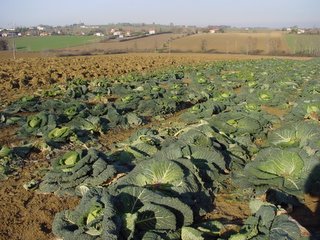 When is a pig not a pig? When it is a green chicken.
When is a pig not a pig? When it is a green chicken.Dog walking days along the driveways of France, those thin white lines on the Michelin map that are township roads, numbered C11, D 2, D296. At Chez Franny in Francescas, Dupont leads us past a field of dew sparkled Savoy cabbages now frost-sweetened in the field. The photograph I took recalled the painting Franny made, which made me think of the very rural regional dishes like a Poule Verte or Green Chicken that Vetou first taught me when I came to this Long Village.
So what does this have to do with the Some Pig Blogging Weekend and my Gascon alphabet? Don’t worry, everything is connected here in the Long Village; rivulets of thoughts lead to streams of consciousness, to raging rivers of words and tidal surges of estuarial action!
This all-important pig... The queen cut of the pig is, of course, the ham—the piece for which we wait the longest: the most expensive, the saltiest, sweetest, most flavorful morsel. Pig butchery time is just around the corner, last year’s pig is mostly gone, and already I am at the ‘J’ word. Jambon. I’ll have to do what we do here in Gascony and make a simple cabbage dish with just the end bits left from last year’s ham or a piece of ventrèche (rolled salted pork belly/bacon). This stuffed ham-scented whole cabbage takes the place of the hen in the traditional poule-au-pot – Good King Henri the 4th’s favorite dish. There are days, even now, when there isn’t a chicken in every pot!
chou by Franny Golden
Vetou Pompèle told me how to make this dish many years ago in front of her French kitchen fireplace. She would assume that you would have all the basic ingredients at hand: a fat Savoy cabbage, some carrots, leeks, courgettes, onions, shallots, and garlic; good farm eggs and sturdy bread, duck fat, milk, and fresh herbs like thyme and parsley, sea salt and lots of freshly ground black pepper and some nutmeg. That’s the basic pantry. Now add a chunk of old ham, (a little rancid ham fat is often used to flavor a soup) or some ventrèche, lardons, or bacon.
Put a big pot of salted water on and when it comes to a boil, blanch the whole cabbage for 5 minutes then drain. While the cabbage is cooking and then cooling, make the stuffing by sautéing until golden a large handful of chopped vegetables like onion, celery and shallots in some duck fat (This IS Southwest France!); tear up enough old bread to make 2-3 cups; moisten this dry bread with some milk, water or wine and squeeze the bread until it is crumbly; add the cooked vegetables, chopped parsley and fresh thyme and roughly chopped up salty pig parts; crack one or two fresh eggs into the mixture, and add salt, nutmeg and pepper- a lot. Now get your hands in and squish the stuffing until it is well mixed. Taste it. Adjust the seasoning. None of this is precise. It’s about making do.
Put another big pot of water on to boil and add the soup vegetables, peeled and cut into big chunks or left whole- carrots, leeks, potatoes, courgettes, some summer-canned tomatoes, etc., add a bouquet garni, salt and a few peppercorns and bring to a simmer.
While the soup starts to simmer, take the cooled cabbage and peel back the leaves gently, until you get to the ‘heart’ – the size of the amount of stuffing you made. Remove this core with a knife or by twisting it out and you will have a hollow whole cabbage. Stuff the hollow with the farce you’ve just made and pull the leaves back over the core, reconstructing the cabbage. Here, I’d use an old gauze ham bag (used to age the ham in the barn) to bundle the cabbage up, but a piece of cheese cloth, an old kitchen towel or even several wraps of kitchen twine will work. Now lower the ‘green chicken’ into the simmering soup and cook until the vegetables are tender and the soup is flavorful. Around 45 minutes. Taste. Often. It’s fun.
When done, serve the soup like a first course with some crusty bread rubbed with garlic floating in the tureen. Then as the main course, serve the stuffed cabbage cut into wedges with the cooked vegetables. I often make a capery-tomato sauce to serve with this though some people just use cornichons, or mustard to offset the sweet vegetables.

There you go, Adam. A very regional winter dish duplicated across France’s most practical agricultural areas using the best of the last bits of that ham that we are about to make all over again…next week. In anticipation and appreciation…‘J’ is for Jambon- le Prince de Janvier!
January 02, 2006
SOME PIG Blogging Weekend
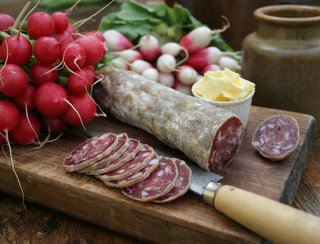 J will be for Jambon later--a tribute to le prince de Janvier.
J will be for Jambon later--a tribute to le prince de Janvier.Once upon a time… there was a Diva living in Italy and a Barge Queen afloat on the French canals who, thanks to the sometimes miracle of rural internet connectivity, shout, pout and raise some delicious ideas—separately and together. The latest idea launched was to submit a seminar on a subject near and dear to their hearts- the preserving of artisan food traditions, especially those that preserve food while preserving culture. Thus was born “Saints Preserve us!-a pig’s tale of three cultures” to be presented on March 30 at the 2006 IACP conference in Seattle.
Judy collects holy cards and breaks butcher’s hearts like nobody’s business; Kate kills pigs down on the Gascon farm every winter. They asked Fergus Henderson of St. John’s Restaurant in London to complete their European trio of pig-loving cooks and share his ‘nose to tail’ ever-so-wry take on British cookery: from Farm to Butcher shop to the Table. Fergus said yes, “my love of things cured and porky” so the Slow Pig race is off and running.
March 30 is a not far off and to booster the events to take place (including the conference presentation with tastings, an auction package of Pigs-in-a-Basket, lunch at Salumi’s, and a ferry ride with pig snacks- a barge queen’s tradition) we decided to launch a virtual Blessing of the Pig in honor of the Patron Saint of farmyard animals—San Antonio Abate whose feast day is on January 17th.
You, too, can participate! In anticipation of celebrating le prince de Janvier a SOME PIG Blogging Weekend is dedicated to the bacon loving, sausage making, boudin nibbling, charcuterie mavens amongst you. Devote some or all of the weekend of Jan 14-15 to preserving, preparing, photographing or just writing about a favorite dish featuring the other white meat, send us the link to your porky post by Sunday night the 15th and we’ll post the participants on Jan 17th in honor of San Antonio Abate day. Since we all like getting presents, we’ll offer our favorite post (meaning there will be two at least!) a fabulous basket of Italian and French pork doctoring products: fennel pollen, épice rabelais, prune salt, etc…
With the flush of new books on charcuterie, salumi, and artisan butchery let alone all the great pig-prone blogs out there…there should be no shortage of good food being cooked. Of course, we’ll be talking about Piggy things from here out and Judy has proposed Fridays with Fergus on the new www.goingwholehog.blogspot.com site while preparing one of his succulent and homespun meals from “Nose-to-Tail” just to get you in the mood.
Don't forget January 14-15- SLOW PIG Blogging Weekend celebrating the bounty of the barnyard! Encouraging bloggers everywhere to eat their favorite pigs, one piece at a time.







